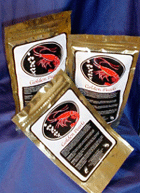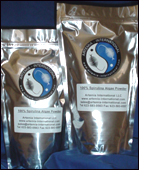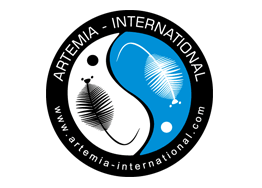TECHNICAL INFORMATION SHRIMP LARVAL AND ENRICHMENT FEEDS
GOLDEN PEARLS
 Golden Pearls is a complete range of micro encapsulated diets for shrimp larvae as well as ornamental fish applications. This larval diet is a result of a revolutionary technique involving a new micro-encapsulation process for the smallest particles (5-50 µm) and an innovative agglomeration of micro-encapsulated particles to produce larger particles (50-100µm, 100-200 µm, 100-200 µm, 200-300 µm, 300-500 µm, 500-800 µm). The technology for the production of these particles results in a highly palatable and digestible diet that mimics live Artemia nauplii. In commercial shrimp hatcheries, Golden Pearls can effectively replace 50-80% of the live food requirement for marine shrimp larviculture without compromising post-larvae quality.
Golden Pearls is a complete range of micro encapsulated diets for shrimp larvae as well as ornamental fish applications. This larval diet is a result of a revolutionary technique involving a new micro-encapsulation process for the smallest particles (5-50 µm) and an innovative agglomeration of micro-encapsulated particles to produce larger particles (50-100µm, 100-200 µm, 100-200 µm, 200-300 µm, 300-500 µm, 500-800 µm). The technology for the production of these particles results in a highly palatable and digestible diet that mimics live Artemia nauplii. In commercial shrimp hatcheries, Golden Pearls can effectively replace 50-80% of the live food requirement for marine shrimp larviculture without compromising post-larvae quality.
Typical Analysis
| Crude Protein (%) | 60.0 |
| Crude Fat (%) | 16.0 |
| Crude Cellulose (%) | 0.50 |
| Crude Ash (%) | 9.50 |
| Phosphorus (%) | 1.70 |
| Copper (ppm) | 50 |
| Vit A (IU/kg) | 20000 |
| Vit D3 (IU/kg) | 4000 |
| Vit E (ppm) | 400 |
| Vit C (ppm) | 1100 |
Available Sizes:
05-050 µm
50-100 µm
100-200 µm
100-200 µm
200-300 µm
300-500 µm
500-800 µm
Instructions for use:
Feed one to four kilos of Golden Pearls per million PL. Feed 3 to 10 g/m3/day. Feed 4 to 6 times per day. Specific feeding regimes are available on request.
Recommended Feeding Table (Grams / m3 / day – divide into 6 feedings per day)
|
Day |
Larval Stage |
Golden |
Golden Pearls |
Golden Pearls |
Golden Pearls |
Golden |
Golden Pearls 500 -800µm |
|
1 |
N5 |
|
|
|
|
|
|
|
2 |
Z1 |
|
|
|
|
|
|
|
3 |
Z2 |
|
|
|
|
|
|
|
4 |
Z2-3 |
|
|
|
|
|
|
|
5 |
Z3 |
|
|
|
|
|
|
|
6 |
Z3/M1 |
|
|
|
|
|
|
|
7 |
MI |
|
|
|
|
|
|
|
8 |
MII |
|
|
|
|
|
|
|
9 |
MIII |
|
|
|
|
|
|
|
10 |
PL1 |
|
|
|
|
|
|
|
11 |
PL2 |
|
|
|
|
|
|
|
12 |
PL3 |
|
|
|
|
|
|
|
13 |
PL4 |
|
|
|
|
|
|
|
14 |
PL5 |
|
|
|
|
|
|
|
15 |
PL6 |
|
|
|
|
|
18 |
|
16 |
PL7 |
|
|
|
|
|
20 |
|
17 |
PL8 |
|
|
|
|
|
24 |
|
18 |
PL9 |
|
|
|
|
|
26 |
|
19 |
PL10 |
|
|
|
|
|
28 |
General Characteristics:
A shrimp or fish larvae will feed effectively on micro-particles if the following criteria is present:
- Buoyancy
- Digestibility
- Low leaching and excellent nutrition
In this table, Artemia is an excellent feed source for the conditions mentioned above. However, its effectiveness does decrease noticeably in regards to nutrition. Artemia is deficient in Essential Fatty Acids (EFA). The nutritional value of formulated feeds will of course depend on the experience and skills of the formulator.

Flake food in general is lacking in regards to digestion but their buoyancy is adequate. Extruded crumbles exhibit better digestibility traits but will tend to sink more rapidly. Capsules and agglomerated micro-capsules (Golden Pearls) are an optimal solution to the problems of buoyancy, digestibility and leaching.
Because this product is formulated, Golden Pearls is a viable feed option and supplement to Artemia in regards to product effectiveness and cost savings. The Golden Pearls capsules contain soluble proteins that are essential in the early developmental stages of the shrimp larvae or fish larvae.
The following factors are present:
- The particles do not sink due to the high buoyancy of the micro-capsules.
- The particles are highly digestible as large amounts of soluble proteins are contained and protected within each capsule.
- The leaching is reduced by the very efficient protein wall.
- The formulation technique allows the production of strong units of various sizes. In general, particles composed of multiple smaller capsules are much stronger and digestible compared to a single large capsule.
The SEM picture (scanning electronic microscopy) shows a capsule of the Golden Pearls feed. The capsule is approximately 50 µm in size. Other capsules ranging from 10 to 25 µm are also present.
 |
 |
The following graph is the result of testing conducted at a commercial shrimp hatchery in Ecuador. The application of this product resulted in notable increases in survival rates. The combination of this factor along with the cost savings and the relatively ease in product application has resulted in continued usage of the Golden Pearls larval diet in many shrimp and fish breeding facilities worldwide.

Ingredients and typical composition: Artemia, squid, shrimp and fish proteins, purified fish oils, phospholipids, astaxanthin, vitamins and protected minerals, antioxidants, immuno-modulators.

SPIRULINA SUPERFOOD FOR ORNAMENTAL FISH
WHAT IS SPIRULINA ALGAE?
 Spirulina is one of the most concentrated natural sources of nutrition know for both terrestrial and aquatic animals. Early interest in Spirulina focused mainly on its potential as a source of protein and vitamins. Spirulina is 60-70% protein by weight and is the richest source of Vitamin B-12 and Beta carotene (twenty times that of carrots) and is also loaded with essential fatty acids and minerals. Today, there are several commercial companies in the U.S., China, and India culturing Spirulina primarily as a food supplement for the health food markets. More recently, there has been new interest concerning the therapeutic effects of Spirulina as a "probiotic" or booster for the immune response system in animals and fish.
Spirulina is one of the most concentrated natural sources of nutrition know for both terrestrial and aquatic animals. Early interest in Spirulina focused mainly on its potential as a source of protein and vitamins. Spirulina is 60-70% protein by weight and is the richest source of Vitamin B-12 and Beta carotene (twenty times that of carrots) and is also loaded with essential fatty acids and minerals. Today, there are several commercial companies in the U.S., China, and India culturing Spirulina primarily as a food supplement for the health food markets. More recently, there has been new interest concerning the therapeutic effects of Spirulina as a "probiotic" or booster for the immune response system in animals and fish.
SPIRULINA AS A PROBIOTIC
What are probiotics and why should you feed them to your fish? Probiotic means "that which promotes life", as opposed to antibiotic which means "against life". Both types of therapy have their place in fish husbandry. While antibiotics kill microbes and harmful bacteria after an infection has occurred, the probiotics will help to prevent the infection from occurring in the first place.
Recent studies have found that Spirulina algae functions as a probiotic, allowing the fishes own immune system to function at a higher level of activity. The idea of using probiotics for disease control is receiving greater attention lately due to:
- Ineffectiveness of the available antibiotics and,
- The publics growing interest over the use of probiotics or holistic type medications.
BENEFITS TO USING SPIRULINA ALGAE
Increased and more uniform growth rates when fed at the recommended .5-2.0% inclusion rate.
- Spirulina improves the intestinal flora in fish by the breakdown of otherwise indigestible feed components, thereby extracting more nutrition from the feed.
- The same beneficial flora or bacteria produce vitamins and displace harmful which is why fish fed Spirulina have less intestinal compaction, a slimmer abdomen, and are more resistant to infection.
- Spirulina stimulates the production on enzymes that transport fats within the fish s body. The fish utilized the fat to power growth instead of just storing it and becoming flabby.
Enhances Color
- The 5 ppt carotenoid pigments that are concentrated in Spirulina algae improve and intensify the coloration in fish. This is especially important for koi and goldfish for commanding a higher price in the marketplace. Chlorophyll and phycocyanin also enhance the skin colors.
Increased Survival Rates
- Studies in Japan on marine yellowtail showed that fingerlings fed a ration of 0.5% (5 ppt) spirulina resulted in a significant gain in survival over the non-Spirulina fed group. Similar results were obtained from professional Discus fish breeders whom incorporate Spirulina powder into the diet for newborn Discus fry.
Less Medication
- Fish farmers have found that including Spirulina in the diet reduced the amount of medication or therapeutics that are normally required to treat sick fish. Spirulina also reduced toxicity of medications and may itself have anti-viral properties. Most disease treatments on the market are "water baths" in which the fish must absorb the drug from the aquarium water. Unfortunately, the treatment water is often discharged down the drain into our environment and waterways.
Orally feeding your fish a diet containing Spirulina could effectively reduce or eliminate the need for bath treatments. Using Spirulina algae as a "prophylactic" treatment in place of antibiotics can effectively reduce wastewater pollutants, eliminating costly treatment systems and increases the effectiveness of existing systems.

SELCO
The ideal supplement / enrichment feed for Artemia. For higher productivity and profitability in Aquaculture
- Hatching and enrichment in the same tank
- Bacterial control during the complete Artemia production cycle
- Enrichment at double the Artemia nauplii density
- Production of nauplii with a high nutritional value
- Products developed to meet the specific requirements of different species
- Optimized production techniques
- Manufactured under strict sanitary conditions to ensure a pathogen free solution
- Quality control procedures strictly enforced regarding all materials and procedures (ISO 9001 certification)
- Not for human consumption
Typical Analysis
| Lipids | Min. 67.0% |
| Ash | Max 2.0% |
| DHA / EPA | 1 |
| Sum 3 HUFA | Min. 200 mg/g dwt |
| Vit. A | Min. 1.500.000 IU/kg |
| Vit. D3 | Min 150.000 IU/kg |
| Vit. E | Min. 3.600 mg/kg |
| Vit C (ppm) | Min. 800 mg/kg |
| Emulsion droplets | 0.5-5 um |
| Antioxidant | ethoxyquin |

ClorAm-X™
ClorAm-X™ is a single-phase, dechlorinating (chlorine removing), deaminating (ammonia removing), and dechloraminating (chloramine removing) agent. It is a white powder that is essentially odorless (upon long-term storage the product may develop a very slight odor) and completely soluble in water.
Dosage: use 1 teaspoon (~ 5 mL) per 10 gallon of water.
Storage:
ClorAm-X™ if kept in its original container will remain stable for an indefinite period of time. Store in a cool dry environment. Do not return unused portions to the original container.
Applications:
ClorAm-X™ may be used on fishes intended for human consumption. The United States Food & Drug Administration (FDA) has determined that the use of the chemical that constitutes ClorAm-XTM (sodium hydroxymethanesulfonate) in water with fishes, intended for human consumption, does not come under FDA jurisdiction.
USE WITH CRUSTACEANS AND MOLLUSKS (SHELLFISH):As with fishes intended for human consumption, ClorAm-X™ may be used on shellfish intended for human consumption. In the FDA's letter of determination, the agency states that the use of the chemical that constitutes ClorAm-XTM, in water with aquatic invertebrates (e.g. lobsters, shrimp, crabs, clams, oysters) intended for human consumption, does not come under FDA jurisdiction.
MARINE INVERTEBRATES: During the development of ClorAm-X™, successful shipping tests were conducted with a wide variety of marine invertebrates: shrimp (e.g. penaeids and Stenopus hispidus), Octopus bimaculoides, American lobster, Turbo and Conus snails, Aplysia, various squid species, tropical and cold-water sea stars and sea cucumbers, Metridium and Condylactis anemones, and hermatypic corals (e.g. Trachyphyllia geofroyi). Additionally, over the years that ClorAm-X™ has been on the market, it has been used commercially by soft-shell crab distributors to prevent ammonia accumulation during the period the crabs are held before and during their molting.
FRESHWATER INVERTEBRATES: ClorAm-X™ has also been extensively tested with freshwater mollusks and crustaceans. These have included species of snails, shrimp and crayfish. The product is routinely used for ammonia control in the shipments of both freshwater and marine invertebrates intended for the aquarium and bait trades.
LIVE FISH FOODS: ClorAm-X™ is routinely used in the packaging and shipping of live aquatic invertebrates sold as live fish feeds. Brine shrimp (Artemia spp.), glassworms, bloodworms, blackworms, Daphnia spp., etc., have been, and currently, are being held, shipped and packaged in water treated with ClorAm-X™.
|
To lower 1 mg/L total ammonia:
| ||
| 100 liters | Requires | 3.199 grams or 0.11 ounces |
| 100 gallons | Requires | 0.426 ounces or 12.1 grams |
| 1 gram | Will treat | 31.4 liters or 8.3 gallons |
| 1 ounce | Will treat | 889 liters or 235 gallons |
| 5 lbs | Will treat | 18,794 gallons or 71,143 liters |
| 1 teaspoon | Equals | 1/6 of an ounce or 5 grams |
| 1 tablespoon | Equals | 1/2 of an ounce or 14 grams |
| 1 ounce | Equals | 28 grams |
ClorAm-X™ is a trademark and manufactured by AquaScience Research Group.
ClorAm-X™ is protected under United States and foreign patents.
